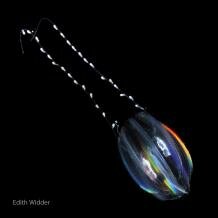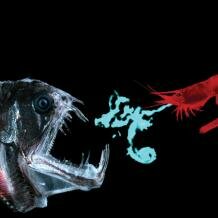Topic: Light producing chemicals: how to make bioluminescence
The most remarkable luciferin in terms of its distribution is known as coelenterazine. This nitrogen-ring based molecule is found in nine separate groups, ranging from radiolarians to fish.
 Flying through the air on a summer’s evening or sparkling in the ocean, magical flashes of light signal some of nature’s most enchanting creatures, those that can generate their own light. Bioluminescence, the capacity of an organism to emit cold light by a natural chemical reaction, is an intriguing feature of creatures as diverse as squid, fish, fungi and beetles. Across the tree of life such light production has evolved independently at least 40 times and in reality more likely more than 50 times: here is convergent evolution on a truly impressive scale.
Flying through the air on a summer’s evening or sparkling in the ocean, magical flashes of light signal some of nature’s most enchanting creatures, those that can generate their own light. Bioluminescence, the capacity of an organism to emit cold light by a natural chemical reaction, is an intriguing feature of creatures as diverse as squid, fish, fungi and beetles. Across the tree of life such light production has evolved independently at least 40 times and in reality more likely more than 50 times: here is convergent evolution on a truly impressive scale.
The wide distribution of bioluminescence points both to its critical ecological importance as well as its rampantly convergent evolutionary origins. Glowing species are known from almost all the major animal phyla as well as certain fungi, protists and bacteria. Bioluminescence serves many functions, both in the dark depths of the ocean and on land. Light emission is used as a means of defence, as an aid to hunting or even to attract potential mates under the cover of darkness. Just how is this light produced? Do the molecules involved tell their own tale of convergence? Yes, they do.
How life emits light: a tale of molecular convergence
 Bioluminescent light is produced as the result of a chemical reaction, typically the oxidation of a photon-emitting compound known as luciferin. Luciferin oxidation is controlled by an enzyme, generally a luciferase (or a photoprotein). To control light emission bioluminescent organisms tend to store luciferin and luciferase separately or keep luciferin hidden within a binding protein until needed. Photoproteins enable reaction control, as they bind the luciferin and oxygen separately until a final cofactor (e.g. Ca2+ or Mg2+ ions) triggers the oxidation reaction. As molecules luciferins are extraordinarily conserved across a range of unrelated taxa, although the structures of the best known luciferases are very different, so providing a special window on convergence. Not only are luciferases and photoproteins highly diverse, but taxon specific. Moreover, species that emit more than one colour (such as the railroad beetles and dragonfish) do so using multiple luciferases or photoproteins.
Bioluminescent light is produced as the result of a chemical reaction, typically the oxidation of a photon-emitting compound known as luciferin. Luciferin oxidation is controlled by an enzyme, generally a luciferase (or a photoprotein). To control light emission bioluminescent organisms tend to store luciferin and luciferase separately or keep luciferin hidden within a binding protein until needed. Photoproteins enable reaction control, as they bind the luciferin and oxygen separately until a final cofactor (e.g. Ca2+ or Mg2+ ions) triggers the oxidation reaction. As molecules luciferins are extraordinarily conserved across a range of unrelated taxa, although the structures of the best known luciferases are very different, so providing a special window on convergence. Not only are luciferases and photoproteins highly diverse, but taxon specific. Moreover, species that emit more than one colour (such as the railroad beetles and dragonfish) do so using multiple luciferases or photoproteins.
Four luciferins seem to drive the great majority of marine bioluminescence, although new luciferins continue to be described, for example in a clam (Phola), as well as various worms, echinoderms and hemichordates.
 In terms of convergence most remarkable is, perhaps, the luciferin known as coelenterazine. This nitrogen-ring based molecule is found in nine separate groups, ranging from the radiolarians (a group of siliceous protists), comb jellies (ctenophores), all cnidarians, a range of crustaceans (decapod and mysid shrimps, halocyprid ostracods, copepods), some brittle stars (ophiuroids), arrow worms (chaetognaths), vampire squid, free swimming tunicates known as larvaceans and some fish (e.g. Diaphus). Coelenterazine is typically synthesised from a tripeptide precursor (Phe-Tyr-Tyr), and those animals that acquire it through their diet seem to depend primarily on crustaceans such as ostracods and shrimp. Coelenterazine is oxidized by very taxon specific luciferases and photoproteins, again underlining the independent evolution of light production in each group.
In terms of convergence most remarkable is, perhaps, the luciferin known as coelenterazine. This nitrogen-ring based molecule is found in nine separate groups, ranging from the radiolarians (a group of siliceous protists), comb jellies (ctenophores), all cnidarians, a range of crustaceans (decapod and mysid shrimps, halocyprid ostracods, copepods), some brittle stars (ophiuroids), arrow worms (chaetognaths), vampire squid, free swimming tunicates known as larvaceans and some fish (e.g. Diaphus). Coelenterazine is typically synthesised from a tripeptide precursor (Phe-Tyr-Tyr), and those animals that acquire it through their diet seem to depend primarily on crustaceans such as ostracods and shrimp. Coelenterazine is oxidized by very taxon specific luciferases and photoproteins, again underlining the independent evolution of light production in each group.
Cypridina luciferin belongs to the same family as coelenterazine. It is found in myodocopid ostracods such as Cypridina noctiluca and Vargula hilgendorfi and is synthesised from a Trp-Ile-Arg tripeptide precursor. The midshipman toadfish (Porichthys) acquires cypridina luciferin (for use in the many photophores on its head and body,) by consuming ostracods such asVargula. A few other fish (e.g. Pempheris, Parapriacanthus) retain the luminescent ostracods in their guts and so, unusually, use their digestive tract as a light organ.
Bacterial luciferin is a tricyclic molecule oxidized by an aldehyde and a luciferase, and these encoded by a genetically conserved ‘lux operon’. Where vast population densities of luminous bacteria occur, such as in warm, upwelling areas of the Indian Ocean, a form of quorum sensing seems to trigger this bacterial light reaction on a huge scale. This leads to glowing ‘milky seas’, tens of thousands of square kilometers in size, and visible from space. While most squid and many fish produce their own light, a number of them have independently acquired these symbiotic luminous bacteria. The bacteria are localized in light-producing organs that serve various functions, from the hunting lures of anglerfish and flashlight fish to the dazzling eye and tentacle spots of deep sea squid.
 Dinoflagellates are swimming protists, some of whom emit flashes of light when disturbed, so making the sea sparkle. Dinoflagellate luciferin is modified from chlorophyll (which is basically a tetrapyrrole) and in autotrophic species luciferin cyclically converts between photosynthesis during the day and bioluminescence at night. Some dinoflagellates, however, are non-photosynthetic and these must either consume chlorophyll or use a novel biosynthesis pathway. An estimated eighteen genera of dinoflagellates emit light (e.g. Pyrocystis, Protoperidnium, Gonyaulax, Noctiluca) and S.H.D. Haddock et al. (Annual Review of Marine Science 2: 443-493; 2010) remark that light production is so critical that these protists allocate energy to light emission before growth. Euphasiid shrimps also use dinoflagellate luciferin, likely due to chemicals retained from dinoflagellates that form part of their diet.
Dinoflagellates are swimming protists, some of whom emit flashes of light when disturbed, so making the sea sparkle. Dinoflagellate luciferin is modified from chlorophyll (which is basically a tetrapyrrole) and in autotrophic species luciferin cyclically converts between photosynthesis during the day and bioluminescence at night. Some dinoflagellates, however, are non-photosynthetic and these must either consume chlorophyll or use a novel biosynthesis pathway. An estimated eighteen genera of dinoflagellates emit light (e.g. Pyrocystis, Protoperidnium, Gonyaulax, Noctiluca) and S.H.D. Haddock et al. (Annual Review of Marine Science 2: 443-493; 2010) remark that light production is so critical that these protists allocate energy to light emission before growth. Euphasiid shrimps also use dinoflagellate luciferin, likely due to chemicals retained from dinoflagellates that form part of their diet.
Cite this web page
Map of Life - "Light producing chemicals: how to make bioluminescence"
https://mapoflife.org/topics/topic_593_light-producing-chemicals-how-to-make-bioluminescence/
March 4, 2021

